Canon 50D: 15.1 Megapixels, ISO 12800, & 6.3 fps
by Wesley Fink on August 26, 2008 1:20 AM EST- Posted in
- Digital Camera
CANON U.S.A. HAS ANNOUNCED THE INTRODUCTION OF THE CANON 50D. The replacement for the prosumer 40D, with a 15.1 Megapixel APS-C size sensor and a 1.6x lens multiplier, will begin shipping in October at a street price of $1399. Below is the Canon Press Announcement with details of the new 50D. We will be posting a review of the 50D when we can get our hands on a production sample, most likely in October.
Canon’s New DIGIC 4 Image Processor Fuels the 15.1 Megapixel Resolution, Expanded ISO Range and Enhanced Noise Reduction of the New EOS 50D Digital SLR
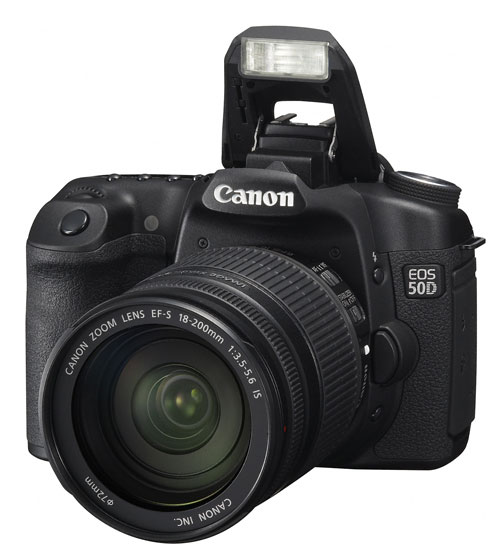
LAKE SUCCESS, N.Y., August 26, 2008 – With the demand for digital SLR cameras reaching unprecedented levels, Canon U.S.A., Inc., a leader in digital imaging, is answering the call with the announcement of the next evolution in advanced amateur digital SLR photography, the EOS 50D Digital SLR Camera with 15.1 megapixel resolution and Canon’s new DIGIC 4 image processor. Designed to offer extraordinary quality and image control for the advanced photographer with a passion for the art, the Canon EOS 50D Digital SLR camera includes an expanded ISO range, improved noise reduction, and in-camera photo editing features. Canon has loaded the EOS 50D camera with a number of enhancements and some trickle-down technology from Canon’s professional Digital SLR cameras, as well as a new Creative Auto Mode (CA) that gives users more creative flexibility to make image setting adjustments conveniently without the need to be a photo expert.
Canon has built upon the success of the popular EOS 40D model – which will remain in Canon’s line – with the EOS 50D Digital SLR camera. Expected to be the camera body of choice for advanced amateur photographers this holiday season, the Canon EOS 50D Digital SLR camera carries over the EOS 40D’s 14-bit Analog-to-Digital conversion process for smooth tones, and also includes enhanced noise reduction, especially at higher ISO ranges which will help bring those romantic nighttime shots into greater focus and clarity. Capable of shooting 6.3 frames per second (fps), the EOS 50D Digital SLR camera is ideal for shooting everything from beautiful night landscapes to fast-action sports.
“Advanced amateur photographers blur the line between the hobbyist and the professional, looking for professional features and capabilities in their equipment that will allow them to capture that awe-inspiring image. Canon is constantly striving to provide these shooters with the most advanced imaging technology, like the new EOS 50D Digital SLR camera, to fuel their passion for photography, and help them achieve their creative potential,” stated Yuichi Ishizuka, senior vice president and general manager, Consumer Imaging Group, Canon U.S.A.
Improved Image Quality
The EOS 50D Digital SLR camera’s 15.1-megapixel CMOS APS-C size image sensor has been improved thanks to the use of newly designed gapless microlenses over each pixel to reduce noise and expand sensitivity up to ISO 12800. The faster processing speed of the camera’s DIGIC 4 image processor contributes to the fast 6.3 frame-per-second (fps) continuous shooting capability (for bursts of up to 90 Large/Fine JPEGs or 16 RAW images on a UDMA CF card), to give shooters the tools they need to capture that perfect moment in perfect clarity.
The Canon EOS 50D camera provides ISO speeds from ISO 100 up to ISO 3200 in 1/3-stop increments, along with two high-speed settings – H1 and H2 – of ISO 6400 and ISO 12800, respectively. Along with a wide ISO range, Canon gives shooters more tools to help maximize clarity and color. The EOS 50D Digital SLR camera offers multiple levels of noise reduction during high-speed shooting. Users can choose from one of four settings– Standard/Weak/Strong/None – to help reduce digital noise that can result from poor lighting conditions.
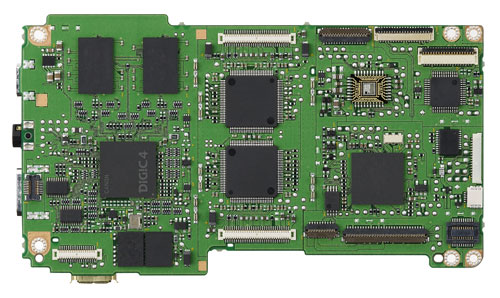
As part of the camera’s internal image processing, the Canon EOS 50D Digital SLR camera conducts peripheral illumination correction, which automatically evens brightness across the image field, making an image of a blue sky even toned throughout, a function previously accomplished through post-processing software on a personal computer. Thanks largely to the DIGIC 4 processor, this automatic adjustment can be made in-camera during shooting with JPEG images or corrected in post-photoshoot processing with RAW images through Canon’s Digital Photo Professional (DPP) software, which is supplied at no extra charge.
Helping to ensure each picture’s subject is clearly visible, Canon’s enhanced Auto Lighting Optimizer analyzes the brightness of subjects and automatically adjusts dark images so that they appear brighter, perfect for subjects in shade or in backlit situations. The Auto Lighting Optimizer on the EOS 50D Digital SLR camera has been updated not only to optimize images while they are being taken, but can also optimize images post-capture, during playback, to help ensure the subject of each image does not appear too dark. This is especially helpful when an amateur photographer uses the camera, because post-capture enhancement can help maximize image quality without the need of a computer.
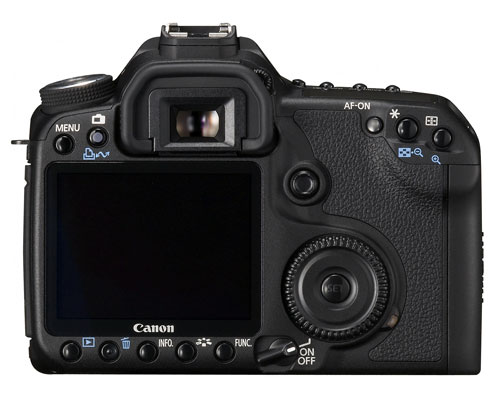
A significant upgrade to the Canon EOS 50D camera is its large, clear 3.0-inch Clear View LCD screen which features 920,000 dot/VGA resolution, four times the pixel count of the EOS 40D camera’s screen, for better clarity and color. To help show off those fantastic shots, the EOS 50D camera includes an HDMI (High-Definition Multimedia Interface) output to display crisp, clear images on a High-Definition TV. The EOS 50D recognizes the needs of today’s photographers, and the faster processing speed of the DIGIC 4 processor helps support UDMA cards for faster writing of image files.
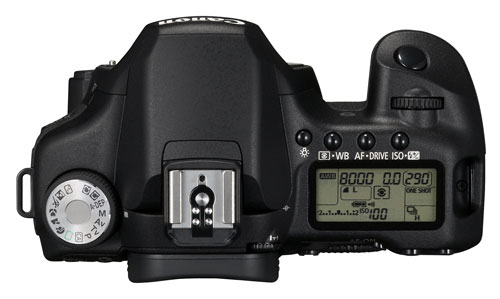
The camera is also equipped with a high-performance viewfinder featuring 0.95x magnification and the same high-performance Autofocus (AF) system as the EOS 40D camera with nine cross-type sensors for accurate target subject acquisition with lenses possessing maximum apertures of f/5.6 or faster and a high-precision diagonal center cross-type AF point that’s effective with f/2.8 and faster lenses, helping photographers ensure better focus of their targets. The AF Microadjustment feature, originally introduced last year with the Canon EOS-1D Mark III professional digital SLR camera, has also been added to the EOS 50D for maximum control over focusing precision.
Canon Gets Creative For Advancing Amateurs
Canon is taking steps to give advanced amateurs more flexibility with a new “CA” Creative Full Auto setting on the EOS 50D Digital SLR camera’s mode dial. This new setting goes a step beyond Full Auto, by allowing users to make adjustments before shooting while still in an Automatic mode, without needing to know the meaning of technical terms such as aperture, shutter speed, etc. In this mode, the camera menu on the back screen spells out options in common language for average photo enthusiasts, allowing them to “blur the background” or “lighten or darken the image.” These easy-to-comprehend image options will help amateur photographers improve the shots they are capable of taking, while helping them learn new techniques. When in the new CA mode, users will be able to adjust flash settings, brighten or darken images, blur the background, set the camera’s drive mode, and select a picture style directly on the camera’s LCD screen.
Better Live View
For photographers who prefer to frame their shots using the camera’s 3.0-inch Clear View LCD screen, Canon has improved the Live View function of the EOS 50D Digital SLR camera to include “Quick Mode AF,” “Live Mode AF,” and “Face Detection Live Mode AF” that detects up to 35 individual forward-looking faces for better focus and clarity when taking group or portrait shots. The camera’s Quick Mode AF setting flips the mirror down and carries out regular phase-detection autofocus, while the Live Mode AF and Face Detection Live Mode AF use the camera’s CMOS image sensor for contrast detection autofocus. Two detailed grid displays have also been added to Live View shooting as optional settings for easier composition.
Two Small RAW Formats
In addition to the RAW and JPEG image capture modes that photographers are accustomed to, the EOS 50D Digital SLR camera now offers more manageable resolution settings and file sizes with two sRAW recording formats, sRAW1 and sRAW2. At the sRAW1 setting, resolution is 7.1 megapixels with a file size that is approximately 25 percent smaller than a standard 15.1 megapixel RAW image. With the sRAW2 setting, resolution is 3.8 megapixels at less than half the file size of a standard RAW image, retaining all of the flexibility and creative possibilities associated with full-size, conventional RAW images. The EOS 50D is the first Canon Digital SLR that allows the use of RAW and sRAW settings in Basic Zone as well as Creative Zone shooting modes, even further improving the camera’s flexibility.
EOS Integrated Cleaning System
The Self-Cleaning Sensor Unit for the Canon EOS 50D has also been upgraded and now includes a fluorine coating on the low-pass filter for better dust resistance. The Self-Cleaning Sensor Unit uses ultrasonic vibrations to shake dust particles off of the low-pass filter in front of the sensor each time the camera is powered up or shut down. The second part of the system includes a software component where sensor spots are mapped and saved as Dust Delete Data that is attached to the image file for removal during post processing using Canon’s DPP software.
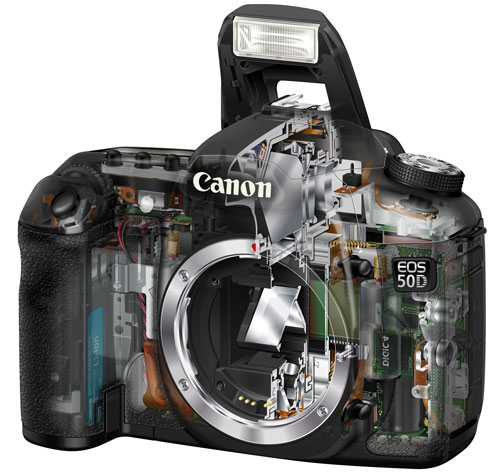
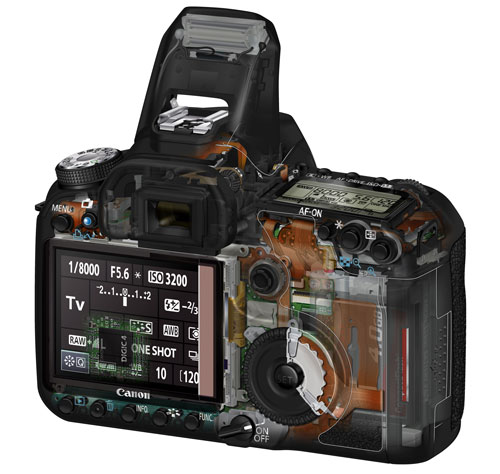
Pricing and Availability
The EOS 50D is compatible with the full lineup of Canon EF lenses as well as the Company’s ever-growing line of affordable EF-S lenses created specifically for Canon Digital SLRs with APS-C size image sensors. The Canon EOS 50D Digital SLR camera is scheduled for October delivery and will be sold in a body-only configuration at an estimated selling price of $1,399.00*. It will additionally be offered in a kit version with Canon’s EF 28-135mm f/3.5-5.6 IS USM zoom lens at an estimated selling price of $1,599.00*.
New EF-S 18-200mm f/3.5-5.6 IS Lens
Canon has answered the call from advanced amateur photographers looking for a solid all-around lens with the introduction of the new EF-S 18-200mm f/3.5-5.6 IS zoom lens. With an incredible focal length range equivalent to 29-320mm in the 35mm format, the new EF-S 18-200mm lens will make an excellent addition to any camera bag, and it gives shooters a great lens to capture both standard as well as telephoto images. The new lens features Canon’s built in Optical Image Stabilization system which gives the equivalent effect of a shutter speed roughly 4 steps faster, for better image clarity, even in shaky shooting conditions. With a minimum focusing distance of 0.45m/1.5 ft. at all zoom settings, this new lens should prove to be ideal for those situations where swapping lenses isn’t an option. An ideal complement to the EOS 50D SLR camera and all other EF-S compatible EOS SLR cameras, the EF-S 18-200mm f/3.5-5.6 IS lens is scheduled to be in stores this October at an estimated selling price of $699.00.










26 Comments
View All Comments
Basilisk - Tuesday, August 26, 2008 - link
Yup... not a bad bit of infomercial, but DailyTech material, not AT, since it lacks critical analysis and benchmarking -- not that I'm yet convinced AT will ever review cameras as well as photo-centric sites.Justin Case - Wednesday, August 27, 2008 - link
It used to be that, when you wanted to see press releases (which are basically ads) surrounded by extra ads, you went to DailyTech.AnandTech used to be the place where you got your editorial ads (i.e., biased "reviews") surrounded by extra ads.
How will we be able to distinguish the two, now?
But hey, at least there are less obvious mistakes (and probably more useful information) in a manufacturer's press release than in your average AT "camera review".
damo - Tuesday, August 26, 2008 - link
Indeed - great press release, but surely if we are going ot start getting this on AT it should be a blog post, or just call it a press release. Letting manufacturer press masquerade as actual articles just degrades the site.strikeback03 - Tuesday, August 26, 2008 - link
Yeah, they probably should have made it more clear that this is just a reprint of the press release, though it is rather obvious.As for the actual announcements, the 50D has a few features I wish my 40D had (AF micro-adjust, hello), though I'll wait and see the IQ on the high ISO images. As for the 18-200, what were they thinking not including USM? I'll stick with my Sigma 18-200 OS, thanks.
keekimaru - Saturday, May 12, 2012 - link
I have been using this camera for last one year. Just to let you know I am a serious amateur photographer who takes mainly landscape photo and sometimes portrait of my kids. My main lenses are: 50mm 1.4, 17-55mm 2.8 and kit lens (28-135mm).First of all, this is a good camera. Good in a sense than it is better than Nikon D90 for its ISO performance (low light), focusing, metering and shutter speed. It has ISO 100 which helps you to take long exposure picture. The CMOS crop sensor is as good as 7D and the only difference with 7D is metering system and megapixel. But believe me if you do not enlarge your photo more than 20"X30" you cannot see the difference AT ALL.
Pros of this camera:
1. Easy to handle. Ergonomic. If you use manual mode you will see how easy to dial the aperture and shutter speed.
2. Good ISO performance. I took some star trail with iso 3200 and the noise still less.
3. LCD screen amazing. Actually thats too good in my opinion.
4. Two pre-seeting is very useful for some known conditions.
5. Picture quality is very good if you have moderate lens.
6. Shutter speed (6.3 fps)- very important if you take sports photo.
Cons:
1. LCD screen so good that you may think all your pics are good. Actually it may not be.
2. Very dim view through viewfinder. Covers only 93%.
3. Only 9 point metering compared to 7D's 21 point.
Overall I should give a 5 star for the qaulity image I get for this price. My only reason giving is 4 star is crop sensor which is not necessarily any bad about this camera. Even you have better budget to buy something expensive I would say go for it and spend the monety to buy good lens.
More Detail : http://www.amazon.com/exec/obidos/ASIN/B001EQ4BY0/...
More Review : http://camera.babybi.com/detail.php?id_detail=41
keekimaru - Friday, August 3, 2012 - link
The Nikon D50 is the only entry-level Nikon DSLR to have the autofocus motor ('screw drive') built into the camera body where the camera is backwards-compatible with mechanical autofocus lenses (Nikkor AF series) dating back to 1989. This feature has been eliminated on later entry-level models and is currently only available on mid-range and advanced models. This makes the D50 the lightest Nikon DSLR to have the autofocus motor.This camera has many settings that can only be accessed by selecting a detailed menu view. One such feature is the ability to shoot HDRI photographs. The camera refers to this setting as BKT (Bracketed Set)
More Detail : http://www.amazon.com/exec/obidos/ASIN/B0009GZANC/...
More Data : http://webcamerawebcamera.com/nikon-d50.php